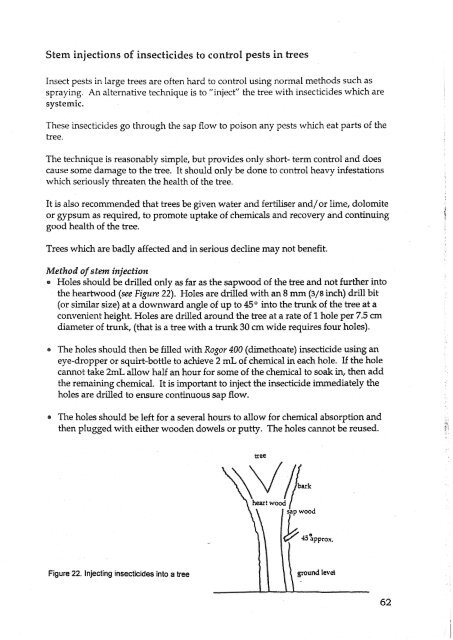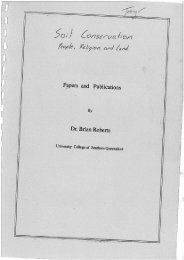western-queensland-gardening-guide.pdf - South West NRM
western-queensland-gardening-guide.pdf - South West NRM
western-queensland-gardening-guide.pdf - South West NRM
You also want an ePaper? Increase the reach of your titles
YUMPU automatically turns print PDFs into web optimized ePapers that Google loves.
Stem injections of insecticides to control pests in trees<br />
Insect pests in large trees are often hard to control using normal methods such as<br />
spraying. An alternative technique is to "inject" the tree with insecticides which are<br />
systemic.<br />
These insecticides go through the sap flow to poison any pests which eat parts of the<br />
tree.<br />
The technique is reasonably simple, but provides only short- term control and does<br />
cause some damage to the tree. It should only be done to control heavy infestations<br />
which seriously threaten the health of the tree.<br />
It is also recommended that trees be given water and fertiliser and/or lime, dolomite<br />
or gypsum as required, to promote uptake of chemicals and recovery and continuing<br />
good health of the tree.<br />
Trees which are badly affected and in serious decline may not benefit.<br />
Method of stem injection<br />
Holes should be drilled only as far as the sapwood of the tree and not further into<br />
the heartwood (see Figure 22). Holes are drilled with an 8 (3/8 inch) drill bit<br />
(or similar size) at a downward angle of up to 4 5 O into the trunk of the tree at a<br />
convenient height. Holes are drilled around the tree at a rate of 1 hole per 7.5 cm<br />
diameter of trunk, (that is a tree with a trunk 30 crn wide requires four holes).<br />
The holes should then be filled with Rogor 400 (dimethoate) insecticide using an<br />
eye-dropper or squirt-bottle to achieve 2 mL of chemical in each hole. If the hole<br />
cannot take 2mL allow half an hour for some of the chemical to soak in, then add<br />
the remaining chemical. It is important to inject the insecticide i<br />
holes are drilled to ensure continuous sap flow.<br />
The holes should be left for a several hours to allow for chemical absorption and<br />
then plugged with either wooden dowels or putty. The holes cannot be reused.<br />
tree<br />
Figure 22. Injecting insecticides into a tree
















